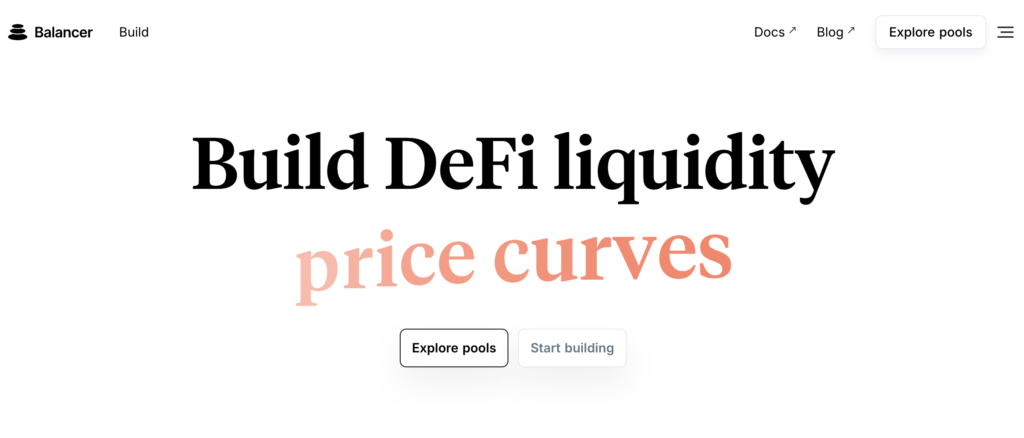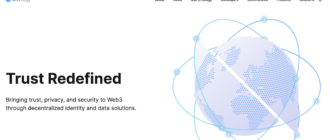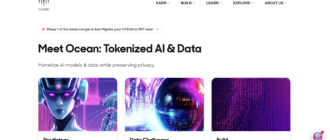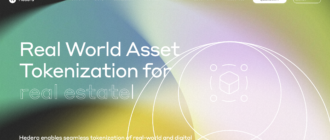Balancer is an automated market maker (AMM) protocol that revolutionizes the way users interact with financial liquidity. By facilitating self-balancing weighted portfolios and price-sensitive automated trading systems, Balancer stands out as a multi-functional platform on the Ethereum blockchain. It offers a flexible and permissionless platform for decentralized finance (DeFi) applications.

Project History
Balancer was conceptualized and developed by Fernando Martinelli and Mike McDonald. Launched in March 2020, it quickly became known for its innovative approach to liquidity provision and trading. Balancer Labs, the entity behind the project, has since garnered significant attention and funding from major entities like Accomplice and Placeholder, underlining its potential and strategic importance in the DeFi space. Throughout its evolution, Balancer has continually added features and partnerships, enhancing its ecosystem and utility.
What is Balancer?
At its core, Balancer is a protocol that allows users to create pools of tokens, which are automatically rebalanced to maintain predetermined ratios, thereby mimicking the concept of an index fund without requiring active management. This functionality addresses the issue of liquidity fragmentation in DeFi by enabling capital efficiency and reducing the cost associated with maintaining portfolio allocations.
How the Balancer Project Works?
Balancer is an advanced protocol within the DeFi space that leverages a range of technologies to optimize automated trading and liquidity provision. The protocol is primarily built on the Ethereum blockchain, which is key to its operation and integration into the wider DeFi ecosystem.
Blockchain and Consensus Mechanism
Balancer is not a standalone blockchain but operates as a set of smart contracts on Ethereum. Ethereum’s blockchain provides the secure and decentralized framework necessary for executing the complex logic of Balancer’s smart contracts. With Ethereum’s shift from Proof of Work (PoW) to Proof of Stake (PoS) in its consensus mechanism, Balancer benefits indirectly from the increased scalability and reduced environmental impact. This transition also means that transactions on Balancer are more energy-efficient and have the potential for faster processing times due to Ethereum’s improved transaction throughput in PoS.
Smart Contracts
The core of Balancer’s functionality lies in its smart contracts, which manage the logic for creating and managing liquidity pools and the automated rebalancing of assets. These contracts are written in Solidity and are deployed on the Ethereum network, ensuring robustness and security through Ethereum’s extensive node network. Each liquidity pool on Balancer can be seen as an automated portfolio, where the ratios of contained assets are maintained according to predefined rules set by the pool creator.
Unique Features and Innovations
What sets Balancer apart from other AMMs are several innovative features:
- Flexible Multi-Token Pools: Unlike traditional AMMs that typically allow pools of only two tokens, Balancer supports up to eight tokens in a single pool. Each token can have an independent weight, affecting the trading logic and the pool’s response to price changes.
- Dynamic Fee Adjustment: Balancer pools can dynamically adjust their trading fees based on market conditions. This feature is designed to maximize returns for liquidity providers during periods of high volatility, thereby aligning incentives between traders and liquidity providers.
- Customizable Pool Types: Balancer offers various pool types, including private, shared, and smart pools. Private pools give a single owner complete control over the pool’s parameters. Shared pools allow for community governance. Smart pools are controlled by smart contracts, allowing for programmable rules that can change the pool’s weights and trading fees based on external conditions.
These technological foundations and unique features make Balancer a powerful tool in the DeFi space, providing users with unprecedented flexibility and control over their liquidity strategies, and making it distinctively adaptive to diverse trading and investment needs.
Tokenomics of Balancer
Balancer operates with a native utility token, BAL, which plays a crucial role in the protocol’s governance and operational mechanisms. BAL is a token, not a coin, as it is not the native currency of its own blockchain but operates on the Ethereum network, adhering to the ERC-20 token standard. This classification influences its utility and integration within the Ethereum ecosystem.
Emission Model and Distribution
BAL tokens are distributed through a process known as liquidity mining, where tokens are awarded to users who provide liquidity to various pools on the Balancer platform. This method ensures that the distribution of tokens is aligned with the usage of the platform, promoting a fair and decentralized allocation of governance rights. The initial supply of BAL was set at 100 million tokens, with a portion allocated for liquidity mining over an extended period to avoid market saturation and price manipulation. This gradual distribution strategy aims to foster long-term engagement and investment in the platform.
Governance and Utility
Holders of BAL tokens have voting rights, which they can exercise in proposals concerning changes to the protocol, such as fee structures, technical upgrades, and the integration of new features. This decentralized governance model ensures that the evolution of the Balancer platform is community-driven and aligned with the interests of its most active users.
Token Value and Market Dynamics
The value of BAL tokens is intrinsically linked to the activity and volume on the Balancer platform. As more users and liquidity enter the platform, the demand for BAL typically increases due to its required role in governance and the incentives provided for liquidity provision. The market price of BAL is subject to fluctuations based on overall market conditions, platform adoption, and changes in DeFi trends. This dynamic is critical for potential investors and users to understand, as it directly impacts the potential returns and strategic positioning of Balancer within the broader DeFi market.
Where to Buy the BAL Token?
The BAL token is available for purchase and trade on a number of prominent cryptocurrency exchanges, ensuring accessibility and liquidity for a wide range of users. Here are some of the major exchanges where BAL can be bought:
- Binance: As one of the largest and most popular cryptocurrency exchanges globally, Binance offers a robust platform with high liquidity for trading BAL tokens. Users can trade BAL against various pairs, including major cryptocurrencies and stablecoins.
- HTX (formerly Huobi): Known for its wide range of available cryptocurrencies and its strong presence in Asian markets, HTX provides a secure and efficient platform for buying and trading BAL.
- MEXC: Offering a wide range of digital assets, MEXC is a popular choice for traders looking for diverse trading options and competitive trading fees for BAL.
- KuCoin: KuCoin is favored for its user-friendly interface and a wide selection of cryptocurrencies. It provides another accessible platform for purchasing BAL tokens.
- Bitfinex: With a longstanding reputation in the cryptocurrency community, Bitfinex offers advanced trading features and high liquidity, making it suitable for trading BAL tokens, especially for more experienced traders.
Where to Store the BAL Token?
For storing BAL tokens, users have a variety of wallet options that provide security and functionality depending on their needs:
- MetaMask: This Ethereum-based wallet is widely used for interacting with DeFi applications. It allows users to store their BAL tokens and also interact directly with the Balancer platform for liquidity provision or governance activities.
- Ledger Nano S/X: For those seeking hardware wallet security, Ledger devices support BAL tokens through their Ethereum application. These wallets offer robust security by keeping tokens offline.
- Trezor: Similar to Ledger, Trezor is a hardware wallet that provides high-level security by storing tokens offline. It supports Ethereum and ERC-20 tokens like BAL, making it a reliable choice for long-term storage.
- Trust Wallet: As a mobile wallet, Trust Wallet offers a practical and secure way to store BAL tokens directly on your smartphone. It supports multiple cryptocurrencies and enables direct interaction with decentralized applications on the Ethereum network.
These wallets not only provide a place to store BAL tokens securely but also give users the flexibility to interact with the DeFi ecosystem, ensuring that they can participate in governance and other platform activities effectively.
Applications and Project Integrations of the Balancer Protocol
Balancer’s protocol is versatile and integral to numerous applications within the decentralized finance (DeFi) landscape. Its innovative liquidity pool and automated market maker functionalities enable a wide range of use cases, from decentralized exchanges to sophisticated portfolio management tools. Below is a detailed overview of specific projects and sectors where Balancer is actively used:
Decentralized Exchanges (DEXs)
Balancer forms the backbone of several decentralized exchanges by providing the necessary liquidity and trading functionalities:
- Balancer Exchange: Its native decentralized exchange platform, which leverages Balancer pools for trading various cryptocurrencies.
- 1inch: A decentralized exchange aggregator that utilizes Balancer pools among others to offer users the best possible trading rates across multiple platforms.
Portfolio Management Solutions
Balancer’s ability to manage self-balancing liquidity pools is employed by various portfolio management applications:
- PowerPool: A protocol that allows for the creation and management of tokenized baskets, utilizing Balancer for underlying liquidity and rebalancing.
Yield Farming and Staking Platforms
Several platforms leverage Balancer’s pools to offer yield farming and staking services, providing users with opportunities to earn passive income:
- Yearn.finance: Integrates with Balancer to optimize yield farming strategies across multiple pools.
- StakeDAO: Uses Balancer pools for liquidity mining programs, distributing rewards to liquidity providers.
Asset Management and Institutional Investment
Balancer’s flexible pool configurations attract institutional investors and asset management platforms:
- Enzyme Finance (formerly Melon Protocol): A platform for on-chain asset management that integrates Balancer pools to diversify investment strategies and manage client portfolios.
Insurance and Risk Management
Balancer is also integrated into DeFi insurance platforms to manage risk pools efficiently:
- Nexus Mutual: Uses Balancer to manage liquidity for its insurance pools, allowing users to buy and sell coverage with improved capital efficiency.
Algorithmic Trading and Automated Strategies
Balancer supports automated trading platforms by providing liquidity pools that can be manipulated based on algorithmic logic:
- PieDAO: Utilizes Balancer for its dough pools, where assets are managed according to algorithmic strategies that automatically adjust their composition.
Governance and Decentralized Autonomous Organizations (DAOs)
Balancer’s governance features are employed by several DAOs to facilitate community-driven management and decision-making processes:
- Balancer DAO: Employs its own protocol for governing the development and upgrades of the Balancer platform, allowing BAL token holders to vote on proposals.
These integrations illustrate Balancer’s extensive utility across the DeFi ecosystem, highlighting its importance not only as a liquidity provider but also as a versatile tool for financial innovation and decentralized governance. The protocol’s widespread adoption underscores its capability to support a variety of financial applications, promoting more open, efficient, and inclusive financial markets.
Future Prospects and Development Forecast
The growth and potential of the Balancer project are anchored in its innovative technology, strategic partnerships, and an expanding ecosystem that responds dynamically to the evolving DeFi landscape. Balancer’s success is primarily driven by its role as a fundamental infrastructure within the DeFi sector, appealing to a diverse range of users including liquidity providers, traders, and other DeFi platforms.
Growth Drivers
- Technological Innovations: Balancer continues to introduce advanced features like customizable liquidity pools and automated rebalancing which keep it at the forefront of the AMM market. These features are essential for attracting users seeking flexible and efficient DeFi solutions.
- Strategic Partnerships: Balancer has established partnerships with leading blockchain and DeFi projects, which enhance its functionality and integration. Notable partnerships include:
- Gnosis: Collaboration for developing the Balancer-Gnosis-Protocol (BGP), which combines Balancer’s pool mechanics with Gnosis’ price finding mechanism.
- Ocean Protocol: Integration to facilitate the data marketplace on Ocean, allowing users to buy and sell data in a decentralized manner.
- Aave: Integration that enables flash loans and other lending functionalities within Balancer pools.
Development Forecast
The outlook for Balancer’s development is optimistic, with plans to further integrate with multiple blockchains and expand its features. The protocol aims to capitalize on the growing interest in multi-chain and cross-chain solutions, potentially increasing its user base and transaction volume. Additionally, the continuous updates to its governance model and incentives for liquidity providers are expected to sustain and attract more investment into the platform.
Ecosystem Expansion
The Balancer ecosystem is comprised of several key components that contribute to its comprehensive DeFi offerings:
- Balancer Pools: Various types of pools including private, shared, and smart pools, each offering different levels of control and flexibility to the pool creators.
- Balancer Exchange: The decentralized exchange functionality built into the platform, enabling users to trade directly from their wallets without intermediaries.
- Balancer Labs: The developmental wing that focuses on innovation and supports the community with grants and funding for projects that wish to build on the Balancer platform.
- Balancer Community: An active community of developers, users, and stakeholders involved in the governance and evolution of the protocol.
In summary, Balancer’s strategic positioning within the DeFi space, coupled with its continuous innovation and robust partnerships, sets a strong foundation for its future growth. The protocol’s adaptability and commitment to expanding its ecosystem are likely to further its adoption and prominence in the blockchain community.
Conclusion
Balancer’s innovative approach to decentralized exchange functions through AMM technology sets it apart in the crowded DeFi space. With strong foundational technology, a robust economic model, and a clear vision for future development, Balancer is well-equipped to continue its growth and play a critical role in the broader blockchain ecosystem. For advanced users and investors, understanding Balancer’s nuanced technologies and strategic potential is essential for navigating the future of decentralized finance.






